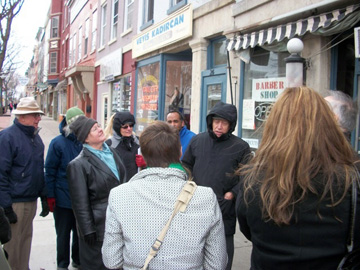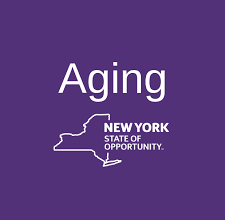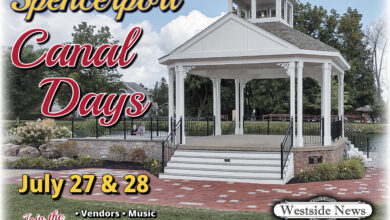Preservation Conference offers tools and inspiration for communities
by Kristina Gabalski
 Bill Andrews discussed and pointed out highlights from two facade improvement programs and answered questions regarding the village’s historic preservation ordinance as well as the history and architectural details of the buildings in the business district between the Erie Canal and State Street/Erie Street during the recent gathering in Brockport.Nearly two hundred people from all over the region and beyond converged on the Village of Brockport Saturday, April 20 for the Landmark Society’s annual preservation conference held in collaboration with the Preservation League of New York State.
Bill Andrews discussed and pointed out highlights from two facade improvement programs and answered questions regarding the village’s historic preservation ordinance as well as the history and architectural details of the buildings in the business district between the Erie Canal and State Street/Erie Street during the recent gathering in Brockport.Nearly two hundred people from all over the region and beyond converged on the Village of Brockport Saturday, April 20 for the Landmark Society’s annual preservation conference held in collaboration with the Preservation League of New York State.
The theme of the 2013 conference was “Outside the Box – Innovative Preservation Practices for the 21st Century.”
Caitlin Meives, a preservation planner with the Landmark Society of Western New York, says the conference was well attended with more participants than usual.
“We’ve had great feedback,” she said late Saturday afternoon, as the last of the conference field sessions were wrapping up. “We had lots of new people and partner organizations.”
Meives said organizations like the Rochester Regional Community Design Center, the Greater Brockport Development Corporation and the Western Monroe Historical Society all helped with the conference.
The conference gives participants “tools and inspiration for making their communities better places,” Meives explained.
Dr. Stephanie Toothman, Associate Director for Cultural Resources at the National Park Service, gave the keynote address on “2016 and Beyond: NPS and the National Historic Preservation Program.” Ruth Pierpont of the New York State Historic Preservation Office gave a lunch presentation on, “A New York State of Mind: Preservation Today and Tomorrow.”
Morning and afternoon session topics included, “Working with your State Historic Preservation Office,” “Engaging Young Professionals in Your Community,” “Main St. LLC: Community Entrepreneurism and the Case for Private Sector Rehab,” “Rehab of the Clarkson Academy,” and field sessions which included a Community Design Charrette led by the Rochester Regional Community Design Center.
Mark Fenton, a Brockport native and nationally recognized public health, planning and transportation consultant and adjunct associate professor at Tufts University’s Friedman School of Nutrition Science and Policy, presented an afternoon conference session on “Creating More Livable, Walkable Communities.”
Fenton said historic communities equal healthy communities – healthy both economically and environmentally.
“I’m prouder than punch of the Village of Brockport,” Fenton said, about his hometown’s work to make their community more inviting to pedestrians and bicyclists.
He explained it is important to develop communities that accommodate and promote “free-range kids,” who can easily walk to school, run an errand and get together with friends.
“We don’t have many free-range kids anymore,” Fenton noted, “We need to design places for free-range kids.”
He said historic towns and villages offer a template for such a community.
“You can walk to school, walk to the corner store – the downtown has many different businesses,” Fenton said.
In such communities, “people are intrinsically more active,” because they can, “… live, work, shop, play and pray,” in the same community, Fenton said.
“People are saying this is what they want,” he explained, “the next generation wants in-town living. They don’t want to have to get in a car all the time.”
Fenton said Brockport is working hard to have such a community. He pointed to things like bikes available at the canal for boaters, bump-outs and curb extensions along Main Street, the round-about and a school that is within the village, all of which help pedestrians and bicyclists.
“I’m very proud of my hometown,” he said. “They have done a phenomenal job on Main Street.”
Later in the afternoon, Fenton led a field session walking the community to assess fundamental elements that encourage and discourage active lifestyles. Brockport Village Trustee, professor emeritus of political science at the College at Brockport and Village Historian emeritus Bill Andrews, also led a field session through the historic business district downtown.
Conference participants heard from Andrews about the preservation successes that have helped create a thriving downtown.



